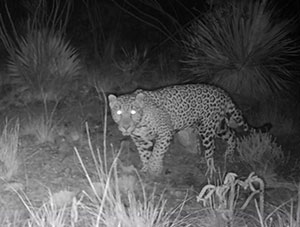
Contact Us
Institutional Communications
Bureau of Mines Building, Room 137
Laramie, WY 82071
Phone: (307) 766-2929
Email: cbaldwin@uwyo.edu
UW, University of Arizona Study Identifies Jaguar Presence at U.S.
Published March 24, 2021

This photo captured an image of a jaguar that identifies that there is a jaguar presence
at the U.S.-Mexico border. The discovery is part of a research project by UW and the
University of Arizona. (Ganesh Marin Photo)
The recent image of a jaguar near the United States-Mexico border by a University of Arizona graduate student with ties to the University of Wyoming suggests that habitat connectivity might remain between the southwestern U.S. and the northernmost jaguar subpopulation in Sonora, Mexico -- more than 100 miles south of the border.
Ganesh Marin, a doctoral student in the School of Natural Resources and the Environment at the University of Arizona and a National Geographic Early Career Explorer, made the discovery recently while reviewing footage from wildlife cameras deployed as part of a research project studying mammal diversity and movements in the borderlands region. In addition to jaguar, the area is rich in biodiversity and provides habitat for many other species, including ocelots, beavers and the Mexican gray wolf.
John Koprowski, Marin’s graduate adviser and professor emeritus at the University of Arizona who joined UW as dean of the Haub School of Environment and Natural Resources last September, leads the project.
“This is an exciting discovery that highlights the importance of finding ways to sustain connectivity of our landscapes so that we can maintain wild and working lands in functional ecosystems today and for future generations,” Koprowski says. “The University of Wyoming and the state have a long history of working to facilitate animal movements and migration, and this new discovery, as part of a joint project by the University of Wyoming and the University of Arizona, adds to our leadership in wildlife conservation.”
Jaguars are the largest species of big cats native to the Americas and are listed as endangered under the Endangered Species Act. Historically, the animals occupied a continuous range extending from central Argentina to the southwestern U.S. states of Arizona, New Mexico and Texas. However, since 1900, that range has decreased due primarily to human disturbance and habitat loss, and is now believed to span an area from northern Argentina to northwestern Mexico.
By 1990, jaguars were thought to have been eliminated from the United States. Although individual cats have been observed in areas of southern Arizona and New Mexico in recent years, the jaguar observed in the project by Marin and Koprowski -- dubbed “El Bonito” -- is almost certainly from the Mexican Pacific subpopulation located in the Mexican state of Sonora and is the most northern jaguar reported for Mexico. The finding indicates the need to maintain and conserve habitat connectivity and water resources on which the animals rely.
The research project is a joint effort of UW and the University of Arizona in collaboration with the Cuenca Los Ojos Foundation and members from Santa Lucia Conservancy, Phoenix Zoo, Arizona State University and National Autonomous University of Mexico.
National Geographic writer Douglas Main will feature the discovery in an upcoming story that can be found here.
Footage of Marin’s discovery is available to view at: www.youtube.com/watch?v=eQhOffmPNro.
About the Haub School of Environment and Natural Resources
UW’s Haub School of Environment and Natural Resources advances the understanding and resolution of complex environmental and natural resource challenges in the West and around the world through educational programming, applied research, outreach and collaborative problem-solving approaches. For more information, visit www.uwyo.edu/haub.
Contact Us
Institutional Communications
Bureau of Mines Building, Room 137
Laramie, WY 82071
Phone: (307) 766-2929
Email: cbaldwin@uwyo.edu
